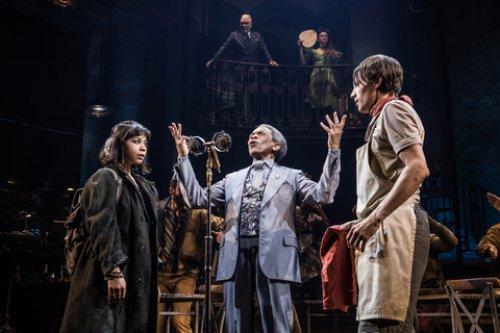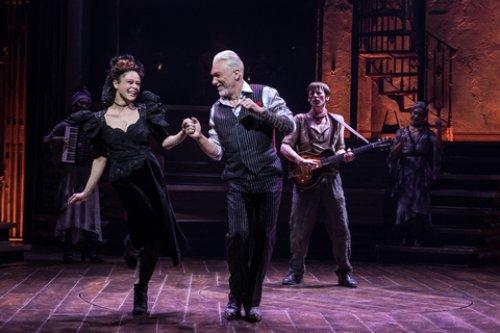Hadestown
Rachel Chavkin turns Anaïs Mitchell’s new folk-rock Depression era musical into a dazzling theatrical event.

Eva Noblezada as Eurydice, André De Shields as Hermes, and Reeve Carney as Orpheus in a scene from Anaïs Mitchell’s “Hadestown” at the Walter Kerr Theatre (Photo credit: Matthew Murphy)
[avatar user=”Victor Gluck” size=”96″ align=”left” ] Victor Gluck, Editor-in-Chief[/avatar]
The dazzling Broadway production of Anaïs Mitchell’s musical Hadestown proves director/developer Rachel Chavkin to be a creative genius. If you had not known it after she fitted her theater-in-the-round production of Natasha and Pierre and the Comet of 1812 into a Broadway theater, it is even more obvious now. This time she has turned her 2016 New York Theatre Workshop staging in the round into a production suitable for Broadway’s Walter Kerr Theatre with its proscenium stage without losing the sense that the musical takes place in many different places. Along with gripping choreography and movement from David Neumann and an onstage jazz band of six, the show simply takes your breath away, telling the joint stories of Orpheus and Eurydice, and Hades and Persephone.
In this Chavkin has been aided by scenic designer Rachel Hauck who makes you feel that her environmental set spills into the audience – which it doesn’t. With its levels and balcony, revolving stage and center platform that rises and falls from below, and its eventual steampunk walls that are revealed later in the show for the descent to Hades, the stage seems to open up continually for each scene without actually changing that much. Of course, much of the credit must go to one of the hardest working casts on Broadway made up of only eight named roles and a chorus of five who pulls us into two classic tales of mythology updated to our own time and tells us, “It’s an old song and we’re gonna sing it again.”
The show began with singer-songwriter Anaïs Mitchell’s concept album in 2010. Chavkin came on board and turned it into an Off Broadway stage production in 2016 with book, music and lyrics by Mitchell. On the way to Broadway, the show was workshopped in Edmonton, Canada, in the fall of 2017, and in London at the National Theatre, from November 2018 to January 2019. Actors Patrick Page as Hades and Amber Gray as Persephone have been with the show from the beginning. André De Shields as Hermes, Reeve Carney as Orpheus and Eva Noblezada as Eurydice joined the show for the London production.

Amber Gray as Persephone, Patrick Page as Hades and Reeve Carney as Orpheus in a scene from Anaïs Mitchell’s “Hadestown” at the Walter Kerr Theatre (Photo credit: Matthew Murphy)
Although the time and place are not specified in this folk-rock musical with jazz overtones, the talk of hard times and hungry people suggests the Great Depression and the hats the band wears and the umbrella occasionally carried by Hermes hint that the bar/lounge the show starts in is New Orleans. Narrated by Hermes, messenger of the gods and mentor to Orpheus, the opening number, “Road to Hell,” is used to introduce us to all of the characters: the three Fates who determine the destinies of mortals; Persephone, goddess of the seasons, who gets off the train with a suitcase full of spring and summertime; her husband Hades, god of the dead, whose factory and mine is at the end of the line; Orpheus, “a poor boy working on a song;” and Eurydice, a backpacker “looking for something to eat,” as well as a Chorus of five who play various roles and back up the lead characters in song and dance.
Orpheus, dressed as a waiter, introduces himself to the streetwise Eurydice, and makes her fall in love with him. They promise to remain faithful to each other while he immerses himself in his music but does not make any money. When autumn comes and the train to take Persephone back to Hadestown and her husband arrives, Eurydice decides to take the ride for food and shelter. She finds Hades’ workers building a wall like zombies who have forgotten the world above.
Eurydice signs a contract with Hades only to discover that she is now his property and can’t leave. Hermes tells Orpheus how to get to Hadestown without using Hades’ train and he arrives only to find that he can’t take Eurydice with him. Inspired by the music of Orpheus, Persephone convinces Hades to give Orpheus a chance. Affected by his song based on a melody he has heard before, Hades has a dilemma: if he lets Eurydice go he loses his power over his factory workers. He decides to leave things to fate with two stipulations. The story follows its old course, and then Hermes begins it again, because people always hope for a different ending – as Persephone gets off the train and Eurydice arrives searching for food.

The Workers Chorus (Timothy Hughes, Afra Hines, Ahmad Simmons, Kimberly Marable and John Krause) in a scene from Anaïs Mitchell’s “Hadestown” at the Walter Kerr Theatre (Photo credit: Matthew Murphy)
Like Hal Prince’s production of the concept album Evita, it was left to Chavkin to think up a scheme to put the almost sung-though score (Hermes has some spoken narration) on stage. With the help of Michael Chorney and Todd Sickafoose who did the arrangements and orchestrations and musical director and vocal arranger Liam Robinson, each song seems to have its own colors making use of trombone, accordion, guitar or piano solos. The staging of such first act songs as “Road To Hell” (Hermes and Company), “Livin’ It Up on Top” (Persephone, Hermes, Orpheus and Company), “Way Down Hadestown” (The Company) and “When the Chips Are Down” (Fates and Eurydice) which use different parts of the stage and different combinations of singers are all show-stopping.
And then follows the pièce de résistance as the finale of the first act in which Eurydice descends to Hades sinking below the stage and in a coup de théâtre finds the whole company engaged in a prescient song, “Why We Build the Wall,” written prior to 2010, with the words “How does the wall keep us free?/The Wall keeps out the enemy,” and the later “Who do we call the enemy?/The enemy is poverty” which bring down the first act curtain with a rousing ovation. The second act has a great many lovely character songs in which we get to know the people better. The songs are brilliantly and colorfully lit by Bradley King, sometimes in blue, sometimes in orange, almost as another character.
The show is not perfect. The problem, which was also true Off Broadway, is that although Orpheus was supposed to have a golden voice and golden lyre, nothing Mitchell has written for Reeve Carney in this character rises to those heights so that Orpheus seems to be just another aspiring singer-songwriter. Some of the other characters have the memorable songs that fulfill this need in the show. So too, we are expected to fall in love with Eurydice but in this role Eva Noblezada is given little to distinguish herself. Carney and Noblezada come across as rather too bland to make us care about them.

Jewelle Blackman, Kay Trinidad and Yvette Gonzalez-Nacer as the Fates in a scene from Anaïs Mitchell’s “Hadestown” at the Walter Kerr Theatre (Photo credit: Matthew Murphy)
The rest of the cast make up for it in aces. Veteran actor De Shields whose breakout role goes back to 1975’s The Wiz is a genial, easy-going and wise narrator and manipulator. Dressed in Michael Krass’s black and white pin-striped suit, Page, with his resonant bass, makes Hades a sinister tycoon out of the Industrial Revolution. Gray who was also directed by Chavkin in Natasha and Pierre… as Hélène, Pierre’s wife, is a perky animated Persephone in the first act and becomes more serious in the second act when she joins Hades in the underworld.
As the Fates, Jewelle Blackman, Yvette Gonzalez-Nacer and Kay Trinidad make beautiful music and close harmony together, most of the time also accompanying themselves on musical instruments. Described by Hades as “the hardest-working chorus in the gods’ almighty world,” Afra Hines, Timothy Hughes, John Krause, Kimberly Marable and Ahmad Simmons live up to that description singing, dancing in various combinations, and working as coal miners in Hadestown.
Hadestown is probably the most exciting musical to be seen in New York at present with its all-inclusive staging, ingenious design, classic story and colorful score in various styles and genres. Credit director/developer Rachel Chavkin with the imagination to not only conceive this production but also to make it all work. If you have seen it in its Off Broadway incarnation it is vastly different with many new songs and an entirely different staging. Miss it at your own peril.
Hadestown (open run)
The National Theatre and New York Theatre Workshop
Walter Kerr Theatre, 219 W. 48th Street, in Manhattan
For tickets, call 877-250-2929 or visit http://www.hadestown.com
Running time two hours and 35 minutes with one intermission






Leave a comment